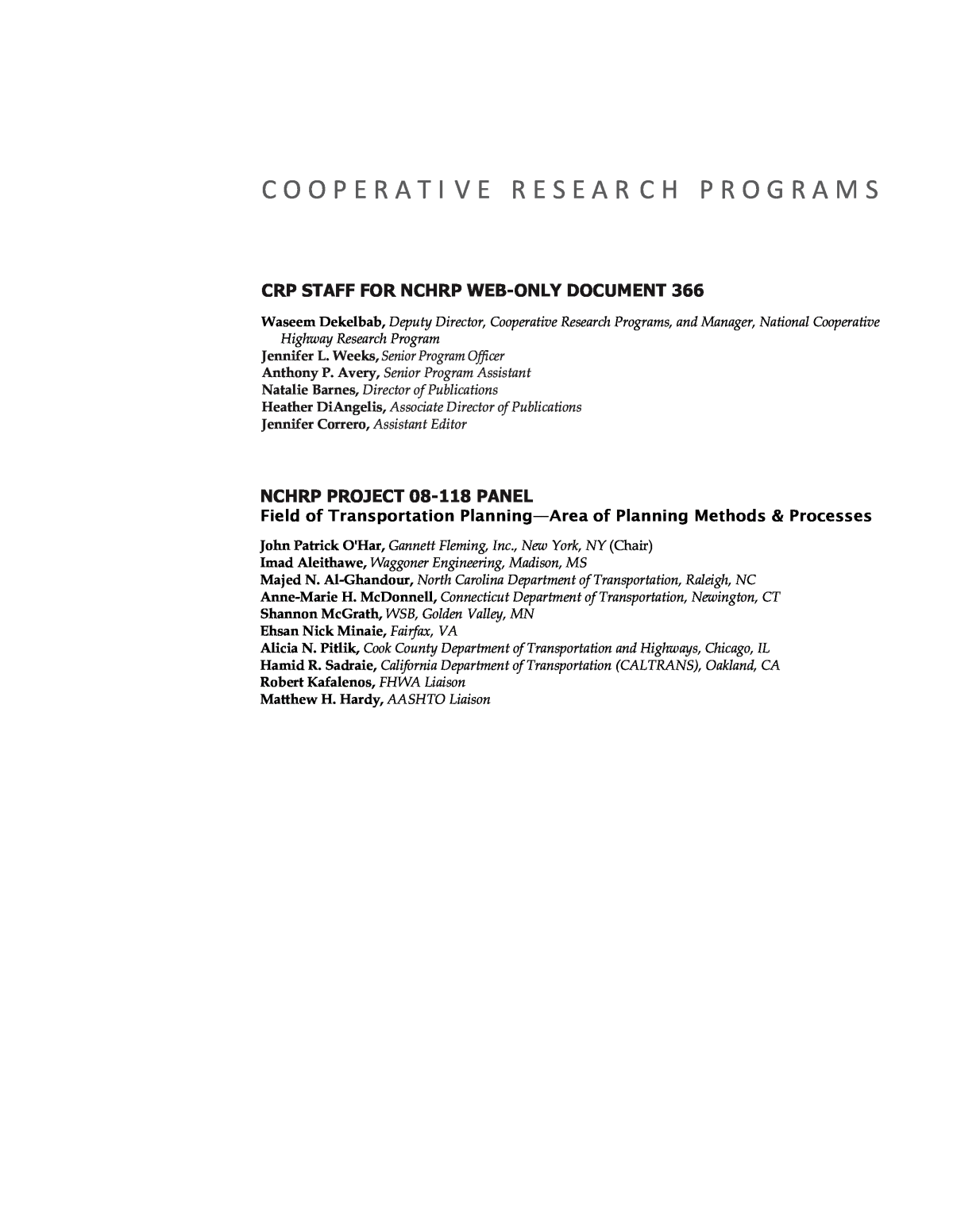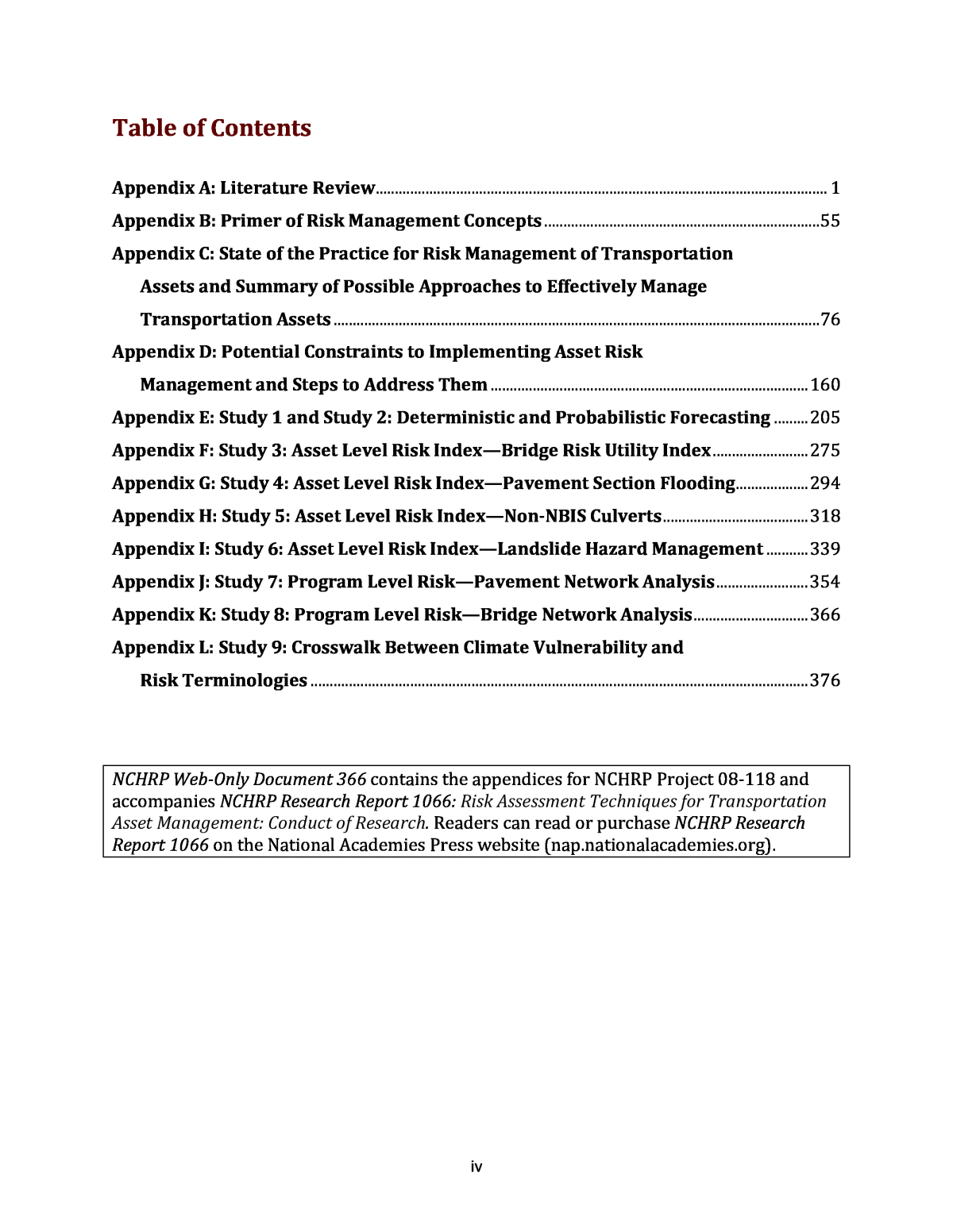



Below is the uncorrected machine-read text of this chapter, intended to provide our own search engines and external engines with highly rich, chapter-representative searchable text of each book. Because it is UNCORRECTED material, please consider the following text as a useful but insufficient proxy for the authoritative book pages.
NCHRP Web-Only Document 366 Risk Assessment Techniques for Transportation Asset Management Appendices Shobna Varma Starlsis Corporation Lewis Center, OH Caroline Dickey Charles Pilson Mott MacDonald Raleigh, NC Gordon Proctor Gordon Proctor & Associates, Inc. Dublin, OH Cassandra Bhat Amanda Vargo Brenda Dix ICF Washington, DC Appendices for NCHRP Project 08-118 Submitted June 2022 © 2023 by the National Academy of Sciences. National Academies of Sciences, Engineering, and Medicine and the graphical logo are trademarks of the National Academy of Sciences. All rights reserved. NATIONAL COOPERATIVE HIGHWAY RESEARCH PROGRAM Systematic, well-designed, and implementable research is the most effective way to solve many problems facing state departments of transportation (DOTs) administrators and engineers. Often, highway problems are of local or regional interest and can best be studied by state DOTs individually or in cooperation with their state universities and others. However, the accelerating growth of highway transportation results in increasingly complex problems of wide interest to highway authorities. These problems are best studied through a coordinated program of cooperative research. Recognizing this need, the leadership of the American Association of State Highway and Transportation Officials (AASHTO) in 1962 initiated an objective national highway research program using modern scientific techniquesâthe National Cooperative Highway Research Program (NCHRP). NCHRP is supported on a continuing basis by funds from participating member states of AASHTO and receives the full cooperation and support of the Federal Highway Administration (FHWA), United States Department of Transportation, under Agreement No. 693JJ31950003. COPYRIGHT INFORMATION Authors herein are responsible for the authenticity of their materials and for obtaining written permissions from publishers or persons who own the copyright to any previously published or copyrighted material used herein. Cooperative Research Programs (CRP) grants permission to reproduce material in this publication for classroom and not-for-profit purposes. Permission is given with the understanding that none of the material will be used to imply TRB, AASHTO, FAA, FHWA, FTA, GHSA, NHTSA, or TDC endorsement of a particular product, method, or practice. It is expected that those reproducing the material in this document for educational and not-for-profit uses will give appropriate acknowledgment of the source of any reprinted or reproduced material. For other uses of the material, request permission from CRP. DISCLAIMER The opinions and conclusions expressed or implied in this report are those of the researchers who performed the research. They are not necessarily those of the Transportation Research Board; the National Academies of Sciences, Engineering, and Medicine; the FHWA; or the program sponsors. The Transportation Research Board does not develop, issue, or publish standards or specifications. The Transportation Research Board manages applied research projects which provide the scientific foundation that may be used by Transportation Research Board sponsors, industry associations, or other organizations as the basis for revised practices, procedures, or specifications. The Transportation Research Board, the National Academies, and the sponsors of the National Cooperative Highway Research Program do not endorse products or manufacturers. Trade or manufacturersâ names appear herein solely because they are considered essential to the object of the report. The information contained in this document was taken directly from the submission of the author(s). This material has not been edited by TRB.
e National Academy of Sciences was established in 1863 by an Act of Congress, signed by President Lincoln, as a private, non- governmental institution to advise the nation on issues related to science and technology. Members are elected by their peers for outstanding contributions to research. Dr. Marcia McNutt is president. e National Academy of Engineering was established in 1964 under the charter of the National Academy of Sciences to bring the practices of engineering to advising the nation. Members are elected by their peers for extraordinary contributions to engineering. Dr. John L. Anderson is president. e National Academy of Medicine (formerly the Institute of Medicine) was established in 1970 under the charter of the National Academy of Sciences to advise the nation on medical and health issues. Members are elected by their peers for distinguished contributions to medicine and health. Dr. Victor J. Dzau is president. e three Academies work together as the National Academies of Sciences, Engineering, and Medicine to provide independent, objective analysis and advice to the nation and conduct other activities to solve complex problems and inform public policy decisions. e National Academies also encourage education and research, recognize outstanding contributions to knowledge, and increase public understanding in matters of science, engineering, and medicine. Learn more about the National Academies of Sciences, Engineering, and Medicine at www.nationalacademies.org. e Transportation Research Board is one of seven major programs of the National Academies of Sciences, Engineering, and Medicine. e mission of the Transportation Research Board is to provide leadership in transportation improvements and innovation through trusted, timely, impartial, and evidence-based information exchange, research, and advice regarding all modes of transportation. e Boardâs varied activities annually engage about 8,000 engineers, scientists, and other transportation researchers and practitioners from the public and private sectors and academia, all of whom contribute their expertise in the public interest. e program is supported by state transportation departments, federal agencies including the component administrations of the U.S. Department of Transportation, and other organizations and individuals interested in the development of transportation. Learn more about the Transportation Research Board at www.TRB.org.
C O O P E R A T I V E R E S E A R C H P R O G R A M S CRP STAFF FOR NCHRP WEB-ONLY DOCUMENT 366 Waseem Dekelbab, Deputy Director, Cooperative Research Programs, and Manager, National Cooperative Highway Research Program Jennifer L. Weeks, Senior Program Officer Anthony P. Avery, Senior Program Assistant Natalie Barnes, Director of Publications Heather DiAngelis, Associate Director of Publications Jennifer Correro, Assistant Editor NCHRP PROJECT 08-118 PANEL Field of Transportation PlanningâArea of Planning Methods & Processes John Patrick O'Har, Gannett Fleming, Inc., New York, NY (Chair) Imad Aleithawe, Waggoner Engineering, Madison, MS Majed N. Al-Ghandour, North Carolina Department of Transportation, Raleigh, NC Anne-Marie H. McDonnell, Connecticut Department of Transportation, Newington, CT Shannon McGrath, WSB, Golden Valley, MN Ehsan Nick Minaie, Fairfax, VA Alicia N. Pitlik, Cook County Department of Transportation and Highways, Chicago, IL Hamid R. Sadraie, California Department of Transportation (CALTRANS), Oakland, CA Robert Kafalenos, FHWA Liaison Matthew H. Hardy, AASHTO Liaison
iv Table of Contents Appendix A: Literature Review...................................................................................................................... 1 Appendix B: Primer of Risk Management Concepts ........................................................................ 55 Appendix C: State of the Practice for Risk Management of Transportation Assets and Summary of Possible Approaches to Effectively Manage Transportation Assets ............................................................................................................................... 76 Appendix D: Potential Constraints to Implementing Asset Risk Management and Steps to Address Them ................................................................................... 160 Appendix E: Study 1 and Study 2: Deterministic and Probabilistic Forecasting ......... 205 Appendix F: Study 3: Asset Level Risk IndexâBridge Risk Utility Index ......................... 275 Appendix G: Study 4: Asset Level Risk IndexâPavement Section Flooding ................... 294 Appendix H: Study 5: Asset Level Risk IndexâNon-NBIS Culverts ...................................... 318 Appendix I: Study 6: Asset Level Risk IndexâLandslide Hazard Management ........... 339 Appendix J: Study 7: Program Level RiskâPavement Network Analysis ........................ 354 Appendix K: Study 8: Program Level RiskâBridge Network Analysis .............................. 366 Appendix L: Study 9: Crosswalk Between Climate Vulnerability and Risk Terminologies .................................................................................................................................. 376 NCHRP Web-Only Document 366 contains the appendices for NCHRP Project 08-118 and accompanies NCHRP Research Report 1066: Risk Assessment Techniques for Transportation Asset Management: Conduct of Research. Readers can read or purchase NCHRP Research Report 1066 on the National Academies Press website (nap.nationalacademies.org).
